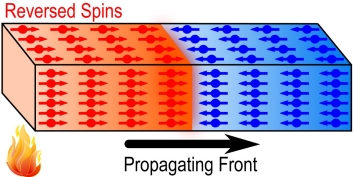May 14 2013
New York University physicists have uncovered how energy is released and dispersed in magnetic materials in a process akin to the spread of forest fires, a finding that has the potential to deepen our understanding of self-sustained chemical reactions.
 Physicists Light “Magnetic Fire” to Reveal Energy’s Path
Physicists Light “Magnetic Fire” to Reveal Energy’s Path
The study, which appears in the journal Physical Review Letters, also included researchers from the University of Barcelona, City College of New York, and the University of Florida. It may be downloaded here.
Forest fires spread because an initial flame or spark will heat a substance—a trunk or branch—causing it to burn, which releases heat that causes the fire to spread to other trunks or branches, turning a small spark into a self-sustained, propagating front of fire that can be deadly and is irreversible.
In the Physical Review Letters study, the researchers sought to understand how energy is sustained and spreads in magnetic materials—“magnetic fire.” Such knowledge is important in designing magnetic materials for energy storage applications. This is because magnetic fire can lead to a rapid and uncontrolled release of stored energy, producing significant energy loss in, for example, an electrical generator.
Research on bursts of energy within magnetic systems dates back two decades. But scientists haven’t been able to measure and understand what prompts this phenomenon, known as “magnetic deflagration.”
Part of this mystery lies in the nature of chemical reactions. In such reactions, which produce heat, the energy released is determined by the chemical constituents and cannot be easily varied. What is known as an “activation energy” is typically necessary to start a chemical reaction; energy is then released as the reaction proceeds. In other words, scientists have concluded that a spark is needed to begin this process—much the same way a forest fire begins with a single lit match.
But in magnetic materials the energies can be manipulated by magnetic fields and are therefore very easily varied in an experiment. Thus the activation energy and the energy released are controllable, enabling systematic studies of the physical mechanisms of energy flow.
To achieve this, the researchers surmised they could produce such a “spark” through a series of spins—the chemical equivalent of striking a match. In this case, they employed small single crystals of a molecular magnet— each magnetic molecule being just one billionth of a meter—that could be magnetized, much like the needle of a compass. The researchers provided a pulse of heat as the spark, causing molecular spins near the heaters to flip in a magnetic field, a process that released energy and transmitted it to nearby material.
“When the molecules’ spins are aligned opposite the applied field direction, they possess a high level of energy,” explained Andrew Kent, a professor in NYU’s Department of Physics and the study’s senior researcher. “And then when the spins ‘flip,’ energy is released and dispersed into surrounding magnetic material that can cause a runaway reaction.”
Moreover, the scientists were able to control the speed of this process by adjusting the make-up of the magnetic field in their experiments. Through this detailed examination, they could see under what conditions energy is released and how it propagates.
“These are exciting results and ones that have prompted us to further consider whether a spark is even necessary to start a magnetic fire,” added Kent. “We hope to observe and study situations in which the fire starts spontaneously, without a spark.”
The study was conducted at NYU by Pradeep Subedi and Saul Velez, both doctoral candidates, as well as Ferran Macia, a postdoctoral researcher, and included: Shiqi Li, a City College of New York (CCNY) doctoral candidate; Myriam Sarachik, a professor at CCNY; Javier Tejada, a professor at the University of Barcelona; Shreya Mukherjee, a University of Florida doctoral candidate; and George Christou, a professor at University of Florida.
The research was supported by a grant from the National Science Foundation’s Division of Materials Research (DMR-1006575, DMR-0451605) and Division of Chemistry (CHE-0910472).